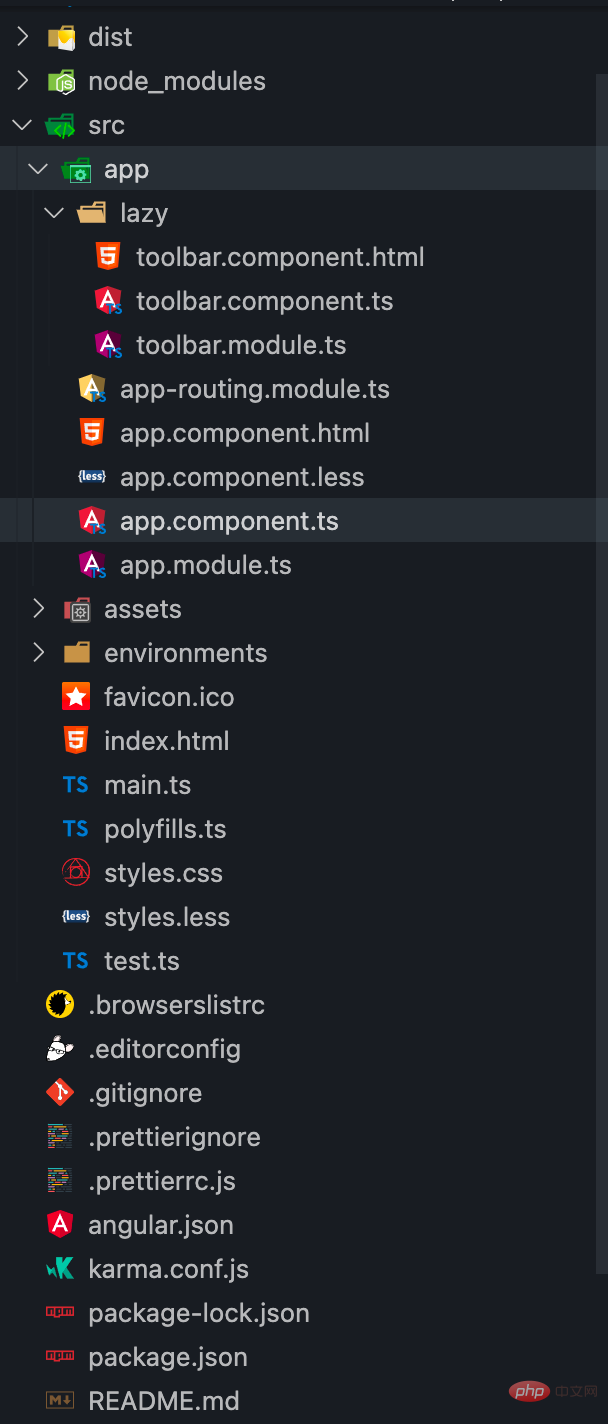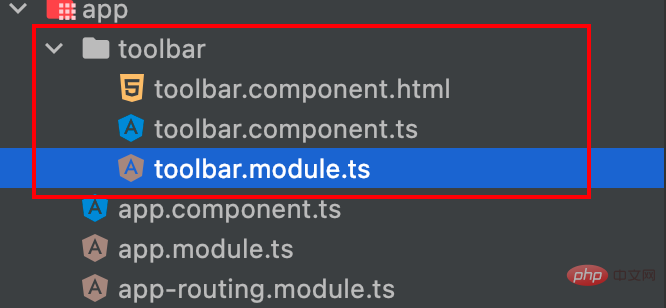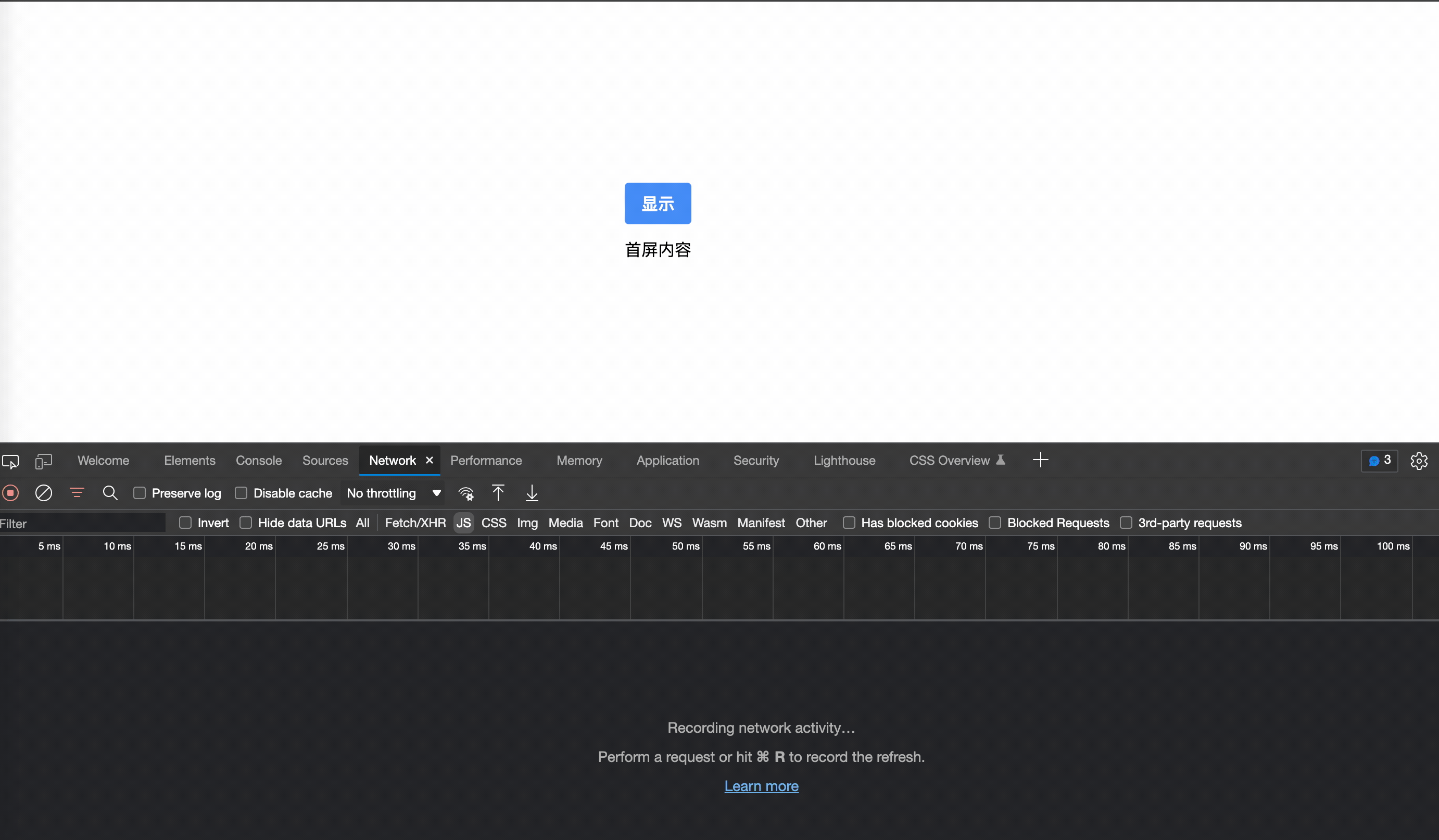聊聊Angular中懶載入模組並動態顯示它的元件

前端(vue)入門到精通課程:進入學習
Apipost = Postman + Swagger + Mock + Jmeter 超好用的API偵錯工具:
環境: Angular 13.x.x
angular中支援可以通過路由來懶載入某些頁面模組已達到減少首屏尺寸, 提高首屏載入速度的目的. 但是這種通過路由的方式有時候是無法滿足需求的。【相關教學推薦:《》】
比如, 點選一個按鈕後顯示一行工具列, 這個工具列元件我不希望它預設打包進main.js, 而是使用者點按鈕後動態把元件載入並顯示出來.
那為什麼要動態載入呢? 如果直接在目標頁面元件引入工具列元件, 那麼工具列元件中的程式碼就會被打包進目標頁面元件所在的模組, 這會導致目標頁面元件所在的模組生成的js體積變大; 通過動態懶載入的方式, 可以讓工具列元件只在使用者點了按鈕後再載入, 這樣就可以達到減少首屏尺寸的目的.
為了演示, 新建一個angular專案, 然後再新建一個ToolbarModule, 專案的目錄結構如圖

為了達到演示的目的, 我在ToolbarModule的html模板中放了個將近1m的base64圖片, 然後直接在AppModule中參照ToolbarModule, 然後執行ng build, 執行結果如圖

可以看到打包尺寸到達了1.42mb, 也就是說使用者每次重新整理這個頁面, 不管使用者有沒有點選顯示工具列按鈕, 工具列元件相關的內容都會被載入出來, 這造成了資源的浪費, 所以下面將ToolbarModule從AppModule的imports宣告中移除, 然後在使用者點選首次點選顯示時懶載入工具列元件.
懶載入工具列元件
首先, 新建一個ToolbarModule和ToolbarComponent, 並在ToolbarModule宣告ToolbarComponent

toolbar.module.ts
import { NgModule } from '@angular/core';
import { CommonModule } from '@angular/common';
import { ToolbarComponent } from './toolbar.component';
@NgModule({
declarations: [ToolbarComponent],
imports: [CommonModule],
exports: [ToolbarComponent],
})
class ToolbarModule {}
export { ToolbarComponent, ToolbarModule };登入後複製toolbar.component.ts
import { Component, OnInit } from '@angular/core';
@Component({
selector: 'toolbar',
templateUrl: './toolbar.component.html',
styles: [
`
svg {
width: 64px;
height: 64px;
}
img {
width: 64px;
height: 64px;
object-fit: cover;
}
`,
],
})
export class ToolbarComponent implements OnInit {
constructor() {}
ngOnInit(): void {}
}登入後複製toolbar.component.html
<p class="flex">
<svg t="1652618923451" class="icon" viewBox="0 0 1024 1024" version="1.1" xmlns="http://www.w3.org/2000/svg" p-id="2104" width="200" height="200"><path d="M412 618m-348 0a348 348 0 1 0 696 0 348 348 0 1 0-696 0Z" fill="#C9F4EB" p-id="2105"></path><path d="M673.19 393h-333a25 25 0 0 1 0-50h333a25 25 0 0 1 0 50zM600.89 235H423.11C367.91 235 323 190.28 323 135.32v-12.5a25 25 0 0 1 50 0v12.5c0 27.39 22.48 49.68 50.11 49.68h177.78c27.63 0 50.11-22.29 50.11-49.68v-16.5a25 25 0 1 1 50 0v16.5c0 54.96-44.91 99.68-100.11 99.68zM673.19 585.5h-333a25 25 0 0 1 0-50h333a25 25 0 0 1 0 50zM467 778H340a25 25 0 0 1 0-50h127a25 25 0 0 1 0 50z" fill="#087E6A" p-id="2106"></path><path d="M739.76 952H273.62a125.14 125.14 0 0 1-125-125V197a125.14 125.14 0 0 1 125-125h466.14a125.14 125.14 0 0 1 125 125v630a125.14 125.14 0 0 1-125 125zM273.62 122a75.08 75.08 0 0 0-75 75v630a75.08 75.08 0 0 0 75 75h466.14a75.08 75.08 0 0 0 75-75V197a75.08 75.08 0 0 0-75-75z" fill="#087E6A" p-id="2107"></path></svg>
<svg t="1652618941842"
class="icon"
viewBox="0 0 1024 1024"
version="1.1"
xmlns="http://www.w3.org/2000/svg"
p-id="2247"
width="200"
height="200">
<path d="M415 624m-348 0a348 348 0 1 0 696 0 348 348 0 1 0-696 0Z"
fill="#C9F4EB"
p-id="2248"></path>
<path d="M695 790H362a25 25 0 0 1 0-50h333a25 25 0 0 1 0 50zM583 649H362a25 25 0 0 1 0-50h221a25 25 0 0 1 0 50zM262 287H129a25 25 0 0 1 0-50h133a25 25 0 0 1 0 50zM262 455.33H129a25 25 0 1 1 0-50h133a25 25 0 0 1 0 50zM262 623.67H129a25 25 0 0 1 0-50h133a25 25 0 0 1 0 50zM262 792H129a25 25 0 0 1 0-50h133a25 25 0 0 1 0 50z"
fill="#087E6A"
p-id="2249"></path>
<path d="M761.76 964H295.62a125.14 125.14 0 0 1-125-125V209a125.14 125.14 0 0 1 125-125h466.14a125.14 125.14 0 0 1 125 125v630a125.14 125.14 0 0 1-125 125zM295.62 134a75.09 75.09 0 0 0-75 75v630a75.08 75.08 0 0 0 75 75h466.14a75.08 75.08 0 0 0 75-75V209a75.09 75.09 0 0 0-75-75z"
fill="#087E6A"
p-id="2250"></path>
<path d="M617 376H443a25 25 0 0 1 0-50h174a25 25 0 0 1 0 50z"
fill="#087E6A"
p-id="2251"></path>
<path d="M530 463a25 25 0 0 1-25-25V264a25 25 0 0 1 50 0v174a25 25 0 0 1-25 25z"
fill="#087E6A"
p-id="2252"></path>
</svg>
<img src="<這裡應該是一張大小將近1M的base64圖片, 內容較大, 就略去了...>" alt="">
</p>登入後複製然後再AppComponent的中按鈕點選事件處理程式中寫載入工具列模組的程式碼:
app.component.ts
import { Component, createNgModuleRef, Injector, ViewChild, ViewContainerRef } from '@angular/core';
@Component({
selector: 'root',
template: `
<p class="container h-screen flex items-center flex-col w-100 justify-center">
<p class="mb-3"
[ngClass]="{ hidden: !isToolbarVisible }">
<ng-container #toolbar></ng-container>
</p>
<p>
<button (click)="toggleToolbarVisibility()"
class="bg-blue-500 hover:bg-blue-700 text-white font-bold py-2 px-4 rounded">{{ isToolbarVisible ? '隱藏' : '顯示' }}</button>
<p class="mt-3">首屏內容</p>
</p>
</p>
`,
})
export class AppComponent {
title = 'ngx-lazy-load-demo';
toolbarLoaded = false;
isToolbarVisible = false;
@ViewChild('toolbar', { read: ViewContainerRef }) toolbarViewRef!: ViewContainerRef;
constructor(private _injector: Injector) {}
toggleToolbarVisibility() {
this.isToolbarVisible = !this.isToolbarVisible;
this.loadToolbarModule().then();
}
private async loadToolbarModule() {
if (this.toolbarLoaded) return;
this.toolbarLoaded = true;
const { ToolbarModule, ToolbarComponent } = await import('./toolbar/toolbar.module');
const moduleRef = createNgModuleRef(ToolbarModule, this._injector);
const { injector } = moduleRef;
const componentRef = this.toolbarViewRef.createComponent(ToolbarComponent, {
injector,
ngModuleRef: moduleRef,
});
}
}登入後複製關鍵在於其中的第32-42行, 首先通過一個動態import匯入toolbar.module.ts中的模組, 然後呼叫createNgModuleRef並傳入當前元件的Injector作為ToolbarModule的父級Injector, 這樣就範例化了ToolbarModule得到了moduleRef物件, 最後就是呼叫html模板中宣告的<ng-container #toolbar></ng-container>的ViewContainerRef物件的createComponent方法建立ToolbarComponent元件
private async loadToolbarModule() {
if (this.toolbarLoaded) return;
this.toolbarLoaded = true;
const { ToolbarModule, ToolbarComponent } = await import('./toolbar/toolbar.module');
const moduleRef = createNgModuleRef(ToolbarModule, this._injector);
const { injector } = moduleRef;
const componentRef = this.toolbarViewRef.createComponent(ToolbarComponent, {
injector,
ngModuleRef: moduleRef,
});
}登入後複製此時再來看下這番操作後執行ng build打包的尺寸大小

可以看到首屏尺寸沒有開頭那麼離譜了, 原因是沒有在AppModule和AppComponent直接匯入ToolbarModule和ToolbarComponent, ToolbarModule被打進了另外的js檔案中(Lazy Chunk Files), 當首次點選顯示按鈕時, 就會載入這個包含ToolbarModule的js檔案
注意看下面的gif演示中, 首次點選顯示按鈕, 瀏覽器網路偵錯工具中會多出一個對src_app_toolbar_toolbar_module_ts.js檔案的請求

更多程式設計相關知識,請存取:!!
以上就是聊聊Angular中懶載入模組並動態顯示它的元件的詳細內容,更多請關注TW511.COM其它相關文章!
